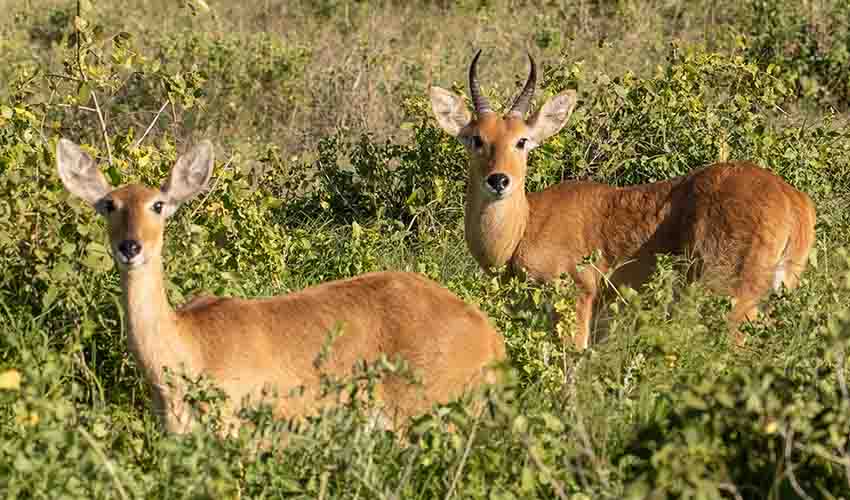Found across a wide swath of sub-Saharan Africa, from Senegal and Ethiopia down to Tanzania and Zambia, this species is most at home near rivers, marshes, and floodplains where tall grasses provide both food and cover. Though not as famous as gazelles or impalas, the bohor reedbuck has its own quiet charm, unique behaviors and adaptations that make it a fascinating animal to watch in the wild.
In appearance, the bohor reedbuck is medium-sized, and its coat is a shaggy, yellowish-brown color, sometimes with gray or reddish tones, blending perfectly with the tall savanna grasses it inhabits. One of its distinctive features is the white patch under its throat and a characteristic whitish ring around the eyes, giving it a slightly gentle, doe-like look. Only males have horns, which are short, forward-curving, and ridged at the base—usually measuring 25–35 cm (10-14 in) in length.
Behaviorally, the bohor reedbuck is both shy and resourceful. During the day, it tends to rest hidden in tall grasses, becoming more active in the early morning, evening, and at night. When alarmed, instead of fleeing in the open like many antelopes, it often drops flat into the grass, relying on camouflage to stay hidden until danger passes. If forced to flee, however, it runs with a distinctive, rocking gait and may emit a sharp, whistling call through its nose—one of the sounds that gave reedbucks their name.
The species is mostly a grazer, feeding on fresh grasses, shoots, and reeds, though it sometimes browses on herbs or shrubs when grasses are scarce. It rarely strays far from water, preferring habitats where tall grass feeds and shelters it.
Distribution
 Benin
Benin Burkina Faso
Burkina Faso Burundi
Burundi Cameroon
Cameroon Central Af. Rep.
Central Af. Rep. Chad
Chad Côte D’ivoire
Côte D’ivoire DR Congo (Kinshasa)
DR Congo (Kinshasa) Eritrea
Eritrea Ethiopia
Ethiopia Gambia
Gambia Ghana
Ghana Guinea-Bissau
Guinea-Bissau Guinea
Guinea Kenya
Kenya Mali
Mali Mauritania
Mauritania Niger
Niger Nigeria
Nigeria Rwanda
Rwanda Senegal
Senegal South Sudan
South Sudan Sudan
Sudan Tanzania
Tanzania Togo
Togo Uganda
UgandaAnything we've missed?
Help us improve this page by suggesting edits. Glory never dies!
Suggest an editGet to know me
Terrestrial / Aquatic
Altricial / Precocial
Polygamous / Monogamous
Dimorphic (size) / Monomorphic
Active: Diurnal / Nocturnal
Social behavior: Solitary / Pack / Herd
Diet: Carnivore / Herbivore / Omnivore / Piscivorous / Insectivore
Migratory: Yes / No
Domesticated: Yes / No
Dangerous: Yes / No




